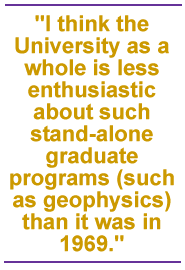 THE UNIVERSITY OF WASHINGTON ALUMNI MAGAZINE
THE UNIVERSITY OF WASHINGTON ALUMNI MAGAZINE
 THE UNIVERSITY OF WASHINGTON ALUMNI MAGAZINE
THE UNIVERSITY OF WASHINGTON ALUMNI MAGAZINE
|
BriefingsMerger Coming for Earth Sciences; Communications Under ReviewTwo mergers in the College of Arts and Sciences could change the way students learn about communications and earth sciences. The Department of Geological Sciences and the Geophysics Program will form a new entity, the Department of Earth and Space Sciences, on March 16. Across campus, a merger between the School of Communications and the Department of Speech Communication is currently under review. Benefits to teaching and research are prompting the mergers, not any cost savings. "We're not just merging to become a department of geology and geophysics. We're reorganizing to become something more than the sum of our parts," says J. Michael Brown, the geophysics chair who will head the new earth sciences department.  "Together we can better coordinate educational offerings for majors and non-majors. Graduate students and faculty from the two departments already work together on research. Being in the same department removes further barriers for interdisciplinary efforts," Brown says. Of the two communications programs, Arts and Sciences Divisional Dean Susan Jeffords says, "Students shouldn't have to choose to study one or the other. It's not fair, especially when employers in the outside world are saying, 'You have to understand both of these.' " The communications departments have been moving closer together for the last five years, and particularly during the last two with the help of a Tools for Transformation grant to set up interdisciplinary courses. The resulting four degree programs—two for undergraduates and two for graduate students—bring together faculty from communications, speech communication, political science and technical communication. "We have had committees working on the broad outlines of a possible merger," says Tony Giffard, director of the School of Communications. "We're trying to come up with a proposal everyone finds attractive," adds Speech Communication Chair Gerry Philipsen. "We're still working on that proposal but I'm optimistic that we can do it." Faculty in both communication departments will vote on the merger this month. If a majority of faculty in each department approve, the new department would likely open its doors in 2002. If a majority in either department vote against the proposal, there would be no merger. The merger for the new earth sciences department was approved by the Board of Regents Feb. 16. Historically, geology has dealt primarily with the Earth's surface, while geophysics delves into everything from the Earth's core to the solar system in which the planet resides. However, in recent years the two branches have come closer to each other, particularly in the way they study the Earth itself. That has paved the way for the combination of the two departments, Brown says. "I think the University as a whole is less enthusiastic about such stand-alone graduate programs (such as geophysics) than it was in 1969," he says. The new department will have more than 30 academic faculty members and nearly 20 research faculty. It will have 60 to 80 graduate students, and about 70 to 100 undergraduates who previously would have been in the geology program.
|